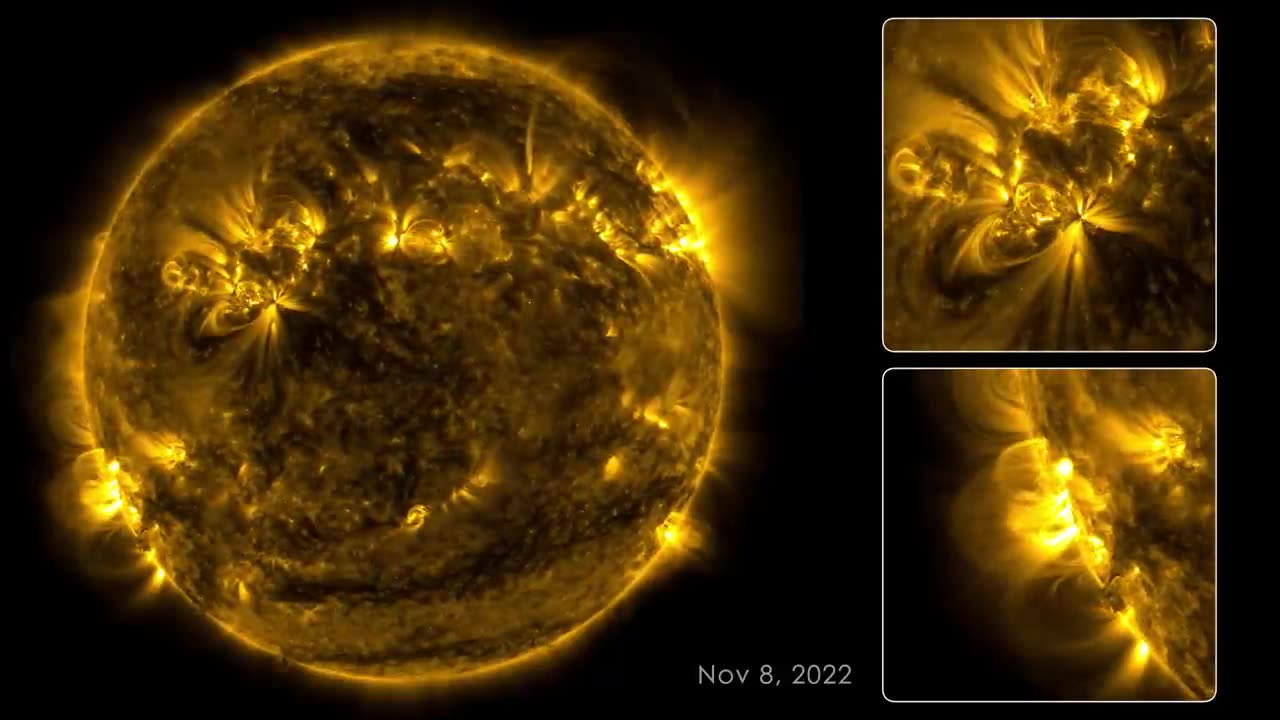Premium Only Content

A Span of 133 Days Within the Sun
This time-lapse sequence documents the solar activity spanning from August 12 to December 22, 2022, meticulously captured by NASA's Solar Dynamics Observatory (SDO). Positioned in space orbit around Earth, SDO has consistently observed the Sun in remarkable 4K x 4K resolution for nearly 13 years. This invaluable data has led to a plethora of fresh insights into the intricate workings of our nearest star and its influential role within the solar system.
Equipped with a trio of instruments, SDO captures a snapshot of the Sun every 0.75 seconds. The Atmospheric Imaging Assembly (AIA) instrument, acting alone, captures images at ten distinct wavelengths of light every 12 seconds. The focus of this 133-day time-lapse revolves around images taken at a wavelength of 17.1 nanometers, revealing the corona—the Sun's outermost atmospheric layer—in the realm of extreme-ultraviolet light.
Through the alignment of images separated by a mere 108 seconds, this visual journey encapsulates 133 days, or approximately four months, of solar observations within a concise 59-minute sequence. The footage showcases vibrant active regions traversing the Sun's surface as it gracefully rotates, completing one rotation about every 27 days.
The enigmatic loops extending above these luminous regions are magnetic fields entrapping heated, radiant plasma. These radiant zones are also the wellspring of solar flares, manifesting as luminous flashes due to magnetic fields coalescing through magnetic reconnection—a dynamic process.
Although SDO has vigilantly focused on the Sun, there are instances it missed. Instances of darkness in the imagery arise when Earth or the Moon briefly block SDO's view of the Sun during transit. Other interruptions stem from instrument maintenance or data discrepancies. SDO diligently transmits an astonishing 1.4 terabytes of data to the ground daily.
Images where the Sun appears off-center denote moments of SDO's instrument calibration. Looking ahead, SDO and fellow NASA missions are poised to maintain their watch over the Sun, continuing to unveil insights about our celestial context while offering crucial information to ensure the safety of astronauts and space assets.
The music accompanying this visual journey is an uninterrupted mix from Lars Leonhard's album "Geometric Shapes," graciously provided by the artist.
Credit: NASA's Goddard Space Flight Center
Scott Wiessinger (PAO): Lead Producer
Tom Bridgman (SVS): Lead Visualizer
Scott Wiessinger (PAO)
#SolarRumbleSaga 🌞⚡
#SunsationalThunder ⚡🌞
#EpicSolarStorm 🌞🌩️
#CosmicRumbleFrenzy 🌌⚡
#RadiantSunEruption ☀️🔥
#SpectacularSolarSymphony 🌞🎶
#CelestialThunderDance ⚡🌟
#SolarShockwaveSensation 🌞💥
#AstroSonicBoom 🚀🔊
#ElectrifyingSunShow ⚡🌞
#SolarEruptionSerenade ☀️🎶
#RumblingCelestialStage 🌌⚡
#SunburstHarmony 🌞🎵
#CosmicThunderstorm ⚡🌠
#RadiantRumbleShow 🌞🔊
#SunSonicSymphony 🌞🎶
#CelestialRumbleMagic ⚡✨
#EnergeticSunbeats 🌞🔊
#SolarRumbleChoreography ☀️💃
#ThunderousSolarEruption ⚡🌞
#SolarRumbleSaga 🌞⚡
#SunsationalThunder ⚡🌞
#EpicSolarStorm 🌞🌩️
#CosmicRumbleFrenzy 🌌⚡
#RadiantSunEruption ☀️🔥
#SpectacularSolarSymphony 🌞🎶
#CelestialThunderDance ⚡🌟
#SolarShockwaveSensation 🌞💥
#AstroSonicBoom 🚀🔊
#ElectrifyingSunShow ⚡🌞
-
 LIVE
LIVE
The Jimmy Dore Show
3 hours agoOfficial Narrative On Charlie Kirk Shooting FALLING APART! Jimmy Kimmel Coming Back! w/ Kim Bright
6,694 watching -
 1:24:12
1:24:12
Katie Miller Pod
4 hours ago $0.72 earnedEpisode 7 - Jillian Michaels | The Katie Miller Podcast
35.1K3 -
 LIVE
LIVE
LFA TV
1 day agoLFA TV ALL DAY STREAM ! | MONDAY 9/22/25
691 watching -
 1:02:10
1:02:10
LIVE WITH CHRIS'WORLD
3 hours agoLIVE WITH CHRIS'WORLD - Key Takeaways From Charlie Kirks Memorial
6.23K -
 1:37:17
1:37:17
Liberty Sentinel
6 days agoURGENT: Dr. Malone Warns of "Vaccine Cult" & Effort to "Fix God Gene" With Shots
6.13K7 -
 LIVE
LIVE
Rallied
4 hours ago $0.45 earnedHigh Octane Warzone Wins All Night
77 watching -
 8:35
8:35
Adam Does Movies
10 hours agoHIM - Movie Review
15.7K3 -
 21:43
21:43
Jasmin Laine
5 hours ago“The Situation Is DETERIORATING”—CTV PANICS as Poilievre HUMILIATES Carney LIVE
16.4K9 -
 1:27:34
1:27:34
The Mike Schwartz Show
6 hours agoTHE MIKE SCHWARTZ SHOW Evening Edition 09-22-2025
14.7K3 -
 1:34:59
1:34:59
Russell Brand
8 hours agoTrump Hails Charlie Kirk A Martyr As 100,000 PACK Arizona Stadium To Honor “American Hero” - SF637
234K57